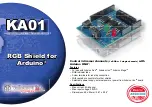
ACS-8960 User’s Manual
72
RAID 5
RAID 5 uses a mathematical expression that compares data from two drives and calculates a
third piece of data called “parity”. Should one of the drives fail, parity data can be used to rebuild
the failed data. Under RAID 5, parity data is stored across all drives in the array. This maximizes
the amount of storage capacity available from all drives in the array while still providing data
redundancy. Data on RAID 5 is block-interleaved.
RAID 5: Independent data disks with distributed parity blocks
Characteristics: Recommended
use:
Each entire data block is written on a data disk.
Parity for blocks in the same rank is generated
on Writes, recorded in a distributed location and
checked on Reads.
Highest Read data transaction, medium Write
data transaction rate.
Relatively low ratio of ECC (Parity) disks to data
disks means high efficiency (compared to other
RAID levels).
Good aggregate transfer rate.
Storage capacity = (No. of disks – 1) × (capacity
of smallest disk)
File and application
servers
Database servers
WWW, E-mail and News
servers
Intranet servers
Most versatile Raid level
Arrangement of data and parity blocks saved on a Level 5 array
















































